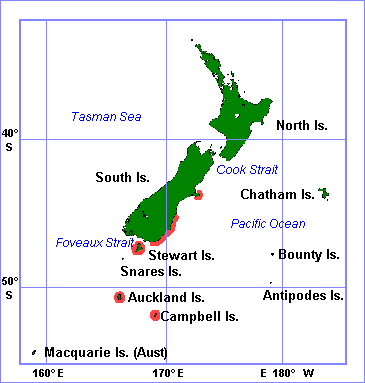


|
|
| |||



| ||||
| .
Photos courtesy of |
|
Yellow-eyed PenguinMegadyptes antipodesBreeding Range: New Zealand Length: 55cm. World Population: 1,500 breeding pairs Of all the species of penguins, the yellow-eyed is one of the world's rarest. Recent estimates consider that only 1200 -1600 breeding pairs remain, of which only 500 are on mainland New Zealand. Its Maori name is "Hoiho" meaning, "the noise shouter". It breeds on the south east coast of the South Island of New Zealand, and as far south as sub Antarctic Campbell Island.
 Yellow-eyed penguin distribution. Map courtesy of New Zealand Penguins
The breeding season is one of the longest in the penguin world, beginning with courtship in August, and continuing until the two chicks fledge in March the following year. They are devoted parents sharing all the nest duties from incubating the eggs to feeding the ever-hungry chicks. Once their chicks have fledged, the parents have up to a month to put on an additional 2 to 3 kg of body-weight before seeking the shelter of the forest to moult. In this 3-week period they are confined ashore as they wait for their old feathers to be replaced. During this vulnerable time they will loose half their total body weight of 5 to 8 kilos. Most yellow-eyed couples stay together year after year. The main reason to seek a new mate is to replace a partner that has died. Their natural predators are sealions, sharks and barracouta, but nowadays that is the least of their worries. Just over 1,000 years ago, explorers from Polynesia arrived to find the forests full of birds and the seas teeming with fish. Maori Moa hunters burnt large areas of forest and grass land in order to flush out the last remaining moas, and the European settlers cleared thousands of acres for farmland. But it was the mammals they brought with them that caused the biggest problem. Rats, mice, cats, dogs, rabbits, deer, possums, pigs, ferrets, stoats and weasels each had a devastating impact on the ecology of this land of birds. The Yellow-eyed Penguin Trust was formed in 1987 in order to put in place a conservation programme that would save the penguins. Working closely with the Department of Conservation, the aim was to restore the coastal forest and control predators. A Plant Nursery was established and a field officer was appointed. Up to 5,000 native plants are now raised each year from locally collected seeds. Cooke Howlison Toyota provided the Trust with a four wheel drive truck, but it was in 1989 when Mainland Products Ltd. became the major sponsor, with a guaranteed $75000 a year donation, that the Trust was really able to see a future and grow. The plight of the penguin was extensively advertised on TV, growing in membership to well over 3000 throughout the country. Priority was given to education and awareness of the problems affecting the Yellow-eyed penguins. Educational resource kits were sent to every school in New Zealand, research work was funded, and the number of habitats managed grew. In 1990 the first property was purchased. Behind the practical fieldwork are many hours of planning and organizing. The nine volunteer Trustees are now assisted by full time and part time staff. Penguin numbers are still below sustainable levels, but it could have been a lot worse had it not been for everyone who contributed, large or small, to the conservation of this unique bird - The Yellow-eyed penguin. Written by Sue Murray, Yellow-eyed Penguin Trust, PO Box 5409, Dunedin, New Zealand .
CLICK HERE to Adopt a Penguin of your very own.
|